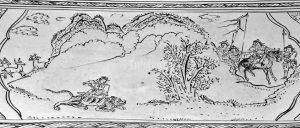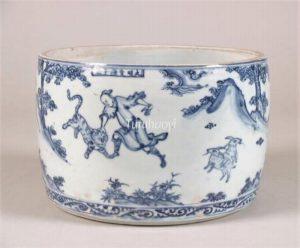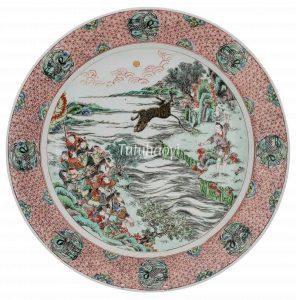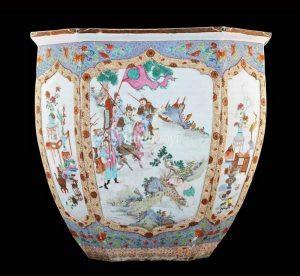Li Cunxiao Slaying a Tiger
李存孝打虎
© Tutuhaoyi.com owns the copyright of the description content for the images attached. Quoting all or part of the description content on this page is permitted ONLY IF ‘Tutuhaoyi.com’ is clearly acknowledged anywhere your quote is produced unless stated otherwise. (本页描述内容版权归Tutuhaoyi.com所有,转发或引用需注明 “Tutuhaoyi.com”, 侵权必究, 已注开源信息的条目除外。)
One day during the Tang dynasty (618-907), Li Keyong (李克用, 856-908), the Prince of Jin (晋王), went out hunting with an entourage of dozens of soldiers, when he encountered a woodcutter in a quiet valley. The woodcutter told Li that The Flying Tiger Hill nearby was an ideal hunting ground. The prince told him that he had dreamt of a flying tiger the night before and wanted him to show his way there. They met a strong gust of wind when reaching the destination and, what was worse, the woodcutter disappeared. A gigantic tiger emerged from the bushes and started charging at the group.
The prince immediately drew out an arrow and shot at the tiger. The tiger let out a cry and jumped to the other side of a creek with the arrow on its back. There was a young man sleeping on the bank with a flock of sheep nearby. The tiger was pouncing on the sheep and woke up the young man. To the onlookers’ great surprise, the young man beat the tiger up with his excellent skills of martial arts. The prince joked with the young man, saying ‘You have killed my pet.’ On hearing this, the young man lifted the tiger and threw it across the creek together with the words ‘You can have it back.’
The prince was impressed by the young man’s extraordinary strength and learned that they both share the same family name ‘Li’. He invited Cunxiao (存孝), the young man, to be his adopted son, who later helped him to win numerous battles.
image identification and story scene description by Dr Yibin Ni
Other story scenes related to the tiger:
Yang Xiang Trying to Throttle the Tiger to Rescue Her Father 杨香扼虎救亲
Fig 1-2: stoneware pillow with glaze and underglaze iron, Cizhou ware, 13th -14th century, courtesy of the Walters Art Museum, Baltimore
Fig 3: incense burner, Jiajing period (1522–66), Ming dynasty, courtesy of Princessehof Ceramics Museum, Leeuwarden
Fig 4-5: porcelain dish with overglaze enamelled decoration, Kangxi period (1662–1722), courtesy of the Jie Rui Tang Collection
Fig 6: famille rose fishtank, Qianlong period (1736–95), Qing dynasty, courtesy of Cohen & Cohen collection, UK
Fig 7: New Year coloured print, Republic Period (1911–1949)






